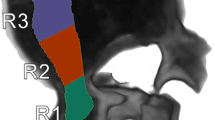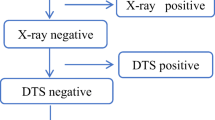Abstract
Purpose
The aim of this study was to evaluate the number, course, width and location of nutrient artery canals of the femur by using multidetector computed tomography (MDCT).
Methods
Sixty-six adult (35 right and 31 left) dry femurs were included in this study and scanned by MDCT. Nutrient artery canals were evaluated on the multi-planar reformatted and volume rendered images which were reproduced on the basis of axial images.
Results
The median value of nutrient artery canals was two (minimum 1 and maximum 6). We determined that there was a negative correlation between the number of nutrient canals and the canal diameters. The outer ostia of the nutrient artery canals were most frequently located at the middle third segment of femoral diaphysis (65%). While the vast majority of the canals were showing upward courses (95%), only a few canals were having transverse (3%) or downward (2%) courses. Most encountered location of outer ostia of the canals according to linea aspera was the medial lip of the linea aspera (44%). Various variations were demonstrated in the number, course, and location of nutrient artery canals using MDCT.
Conclusions
In conclusion, the knowledge of the topographic features of the nutrient artery canals may be useful in various clinical implications such as bone grafting or radiologic evaluation for the fracture lines.




Similar content being viewed by others
References
Bostrom M, Yang X, Koutras I (2000) Biologics in bone healing. Curr Opin Orthop 11:403–412
Bridgeman G, Brookes M (1996) Blood supply to the human femoral diaphysis in youth and senescence. J Anat 188:611–621
Buckwalter KA, Rydberg J, Kopecky KK, Crow K, Yang EL (2001) Musculoskeletal imaging with multislice CT. Am J Roentgenol 176:979–986
Buckwalter KA, Farber JM (2004) Application of multidetector CT in skeletal trauma. Semin Musculoskel Radiol 8:147–156
Gumusburun E, Yucel F, Ozkan Y, Akgun Z (1994) A study of the nutrient foramina of lower limb long bones. Surg Radiol Anat 16:409–412
Kirschner MH, Menck J, Hennerbichler A, Gaber O, Hofmann GO (1998) Importance of arterial blood supply to the femur and tibia for transplantation of vascularized femoral diaphyses and knee joints. World J Surg 22:845–852
Kizilkanat E, Boyan N, Ozsahin ET, Soames R, Oguz O (2007) Location, number and clinical significance of nutrient foramina in human long bones. Ann Anat 189:87–95
Laing PG (1953) The blood supply of the femoral shaft: anatomical study. J Bone Joint Surg Br 35:462–466
Lexer E, Kuligan P, Turk W (1904) Untersuchungen über Knochenarterien. Hirschwald, Berlin
Longia GS, Ajmani ML, Saxena SK, Thomas RJ (1980) Study of diaphyseal nutrient foramina in human long bones. Acta Anat 107:399–406
McKee NH, Haw P, Vettese T (1984) Anatomic study of the nutrient foramen in the shaft of the fibula. Clin Orthop Rel Res 184:141–144
Mysorekar VR (1967) Diaphysial nutrient foramina in human long bones. J Anat 101:813–822
Nagel A (1993) The clinical significance of the nutrient artery. Orthop Rev 22:557–561
Schiessel A, Zweymüller K (2004) The nutrient artery canal of the femur: a radiological study in patients with primary total hip replacement. Skel Radiol 33:142–149
Sendemir E, Cimen A (1991) Nutrient foramina in the shafts of lower limb long bones: situation and number. Surg Radiol Anat 13:105–108
Taylor GI (1979) Fibular transplantation. In: Sefarin D, Burke HJ (eds) Microsurgical composite tissue transplantation. Mosby, St Louis, pp 418–423
Williams PL, Bannister LH, Berry MM, Collins P, Dyson M, Dussek JE, Ferguson MWJ (1995) Pelvic girdle and lower limb. In: Gray’s anatomy, 38th edn. Churchill Livingstone, Philadelphia, pp 1434, 1567
Yamamoto Y, Ohura T, Sugihara T (1995) An anatomic study for a vascularized bone flap of femur. Plast Reconstr Surg 95:520–525
Yamamoto H, Jones DB Jr, Moran SL, Bishop AT, Shin AY (2010) The arterial anatomy of the medial femoral condyle and its clinical implications. J Hand Surg Eur 35:569–574
Conflict of interest
The authors declare that they have no conflict of interest.
Author information
Authors and Affiliations
Corresponding author
Rights and permissions
About this article
Cite this article
Imre, N., Battal, B., Acikel, C.H. et al. The demonstration of the number, course, and the location of nutrient artery canals of the femur by multidetector computed tomography. Surg Radiol Anat 34, 427–432 (2012). https://doi.org/10.1007/s00276-011-0930-7
Received:
Accepted:
Published:
Issue Date:
DOI: https://doi.org/10.1007/s00276-011-0930-7




